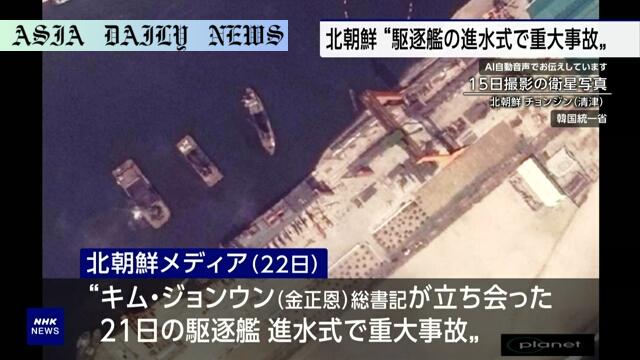Accident: A new North Korean 5,000-ton destroyer suffered damage during its launch ceremony due to operational mishaps.
North Korean destroyer launch fails due to ‘serious accident.’
Kim Jong Un condemns the mishap as a ‘criminal act.’
Officials at fault will face investigation and accountability.

North Korea’s Failed Destroyer Launch: What Happened?
North Korea’s state media recently reported an incident involving its naval forces, pointing to a “serious accident” during the launch of a new 5,000-ton destroyer at Chongjin Shipyard in the nation’s northeast. While such public disclosures of military errors are rare in Pyongyang, the event highlights underlying operational and command-level issues that could have broader implications for the regime.
The mishap occurred during a ceremony attended by Supreme Leader Kim Jong Un, where the destroyer, touted as a critical milestone in North Korea’s naval ambitions, failed to launch successfully. The mishap was attributed to a failure in detaching the ship’s bow from the shipway, leading to what Kim deemed as “irresponsible errors” stemming from “inexperienced command and operational carelessness.” This not only resulted in damage to the vessel but also public condemnation from the regime’s top leader.
Accountability in North Korea’s Military Leadership
Kim Jong Un announced during the aftermath that this “serious accident and criminal act” would not go unaddressed. The leadership’s decision to investigate the incident reflects their dissatisfaction with lapses that could undermine Pyongyang’s carefully constructed facade of military prowess. Senior officials involved in the mishap are set to face scrutiny at the upcoming plenary meeting of the Central Committee of the Worker’s Party, slated for late June.
Experts highlight that publicly acknowledging such a failure is an unusual move for the North Korean regime. This transparency may aim to pre-empt international and domestic speculation. With Kim Jong Un’s regime facing growing scrutiny over its internal governance, this public call for accountability serves a dual function of demonstrating control and projecting an image of responsibility to its citizens and the global community.
Global Implications of North Korea’s Naval Setback
The failed destroyer launch underscores various operational challenges for North Korea. It provides insights into potential gaps in the regime’s technological and organizational capabilities. Despite aggressive posturing in regional security dynamics, this mishap raises questions about Pyongyang’s readiness to operationalize its advanced weaponry and vessels effectively.
South Korea and other nations observing these developments note that such accidents not only point to structural inefficiencies but also stir debates about the competence within Pyongyang’s military-industrial complex. This debacle could impact North Korea’s national image as a self-sufficient country capable of militaristic confidence, affecting its diplomatic leverage with nations in the region and beyond.
Conclusion: Challenges Ahead?
As North Korea continues down its path of heavy militarization and strategic brinkmanship, such setbacks present both internal and external challenges. While the upcoming Central Committee meeting is expected to raise key questions about leadership competency, the regime’s decision to impose consequences on senior officials may appease internal discontent temporarily. However, whether Pyongyang learns critical lessons from this accident remains to be seen. The incident serves as a stark reminder that, even in tightly controlled regimes, human error and systemic flaws cannot always be avoided.



Commentary
The Larger Implications of North Korea’s Naval Mishap
The recent accident involving North Korea’s destroyer launch offers plenty of discussion points, not just for observers of geopolitics but also for those analyzing the world’s most secretive nation. A military blunder of this nature, openly acknowledged by the regime, is not an everyday occurrence within North Korea’s tightly controlled information ecosystem. This raises compelling questions about why Pyongyang chose to broadcast such an internal failure.
The potential reasons are multilayered. Perhaps Kim Jong Un wanted to send a strong message to his allies and subordinates about the importance of accountability. By swiftly declaring the event as a “serious accident” and a “criminal act,” the leader positioned himself as both the arbiter of justice and the protector of national ideals. However, it also exposes cracks in the regime’s ability to project seamless competence, indirectly weakening its standing on the global stage.
North Korea’s Obsession with Power and Perfection
This incident also sheds light on the underlying tensions within Pyongyang’s governance. For a country that thrives on projecting an image of military invincibility, publicizing a naval mishap could be seen as an uncharacteristic admission of fallibility. It contrasts sharply with the hermit kingdom’s usual stance of censoring negative events within its borders.
Moreover, Kim’s decision to investigate and hold officials accountable could reflect a broader attempt to cleanse inefficiencies within the military hierarchy. However, the larger question remains: how effective can such measures be in a system known for suppression, fear, and a lack of constructive transparency? If internal problems continue to proliferate, North Korea risks further undermining its capabilities on the world stage, regardless of how much it projects power through missile tests and aggressive rhetoric.
What’s Next for North Korea?
Looking ahead, the world will closely watch how the Central Committee meeting addresses this high-profile debacle. Will it result in meaningful changes, or will symbolic punishments for a few scapegoats suffice? Additionally, one must consider whether similar incidents have occurred in the past but were quickly concealed. If this incident marks the beginning of a new era of transparency within Pyongyang, it could reshape global perceptions of the regime.
Ultimately, the destroyer accident encapsulates a mix of poor execution, questionable leadership, and systemic flaws. As analysts dig deeper into this rare disclosure, North Korea’s handling of the situation will reveal the robustness—or fragility—of its military ambitions. While Pyongyang continues to aspire for security superiority in the region, it remains to be seen whether such failures will drive reforms or deepen the cracks in its long-running strategies.